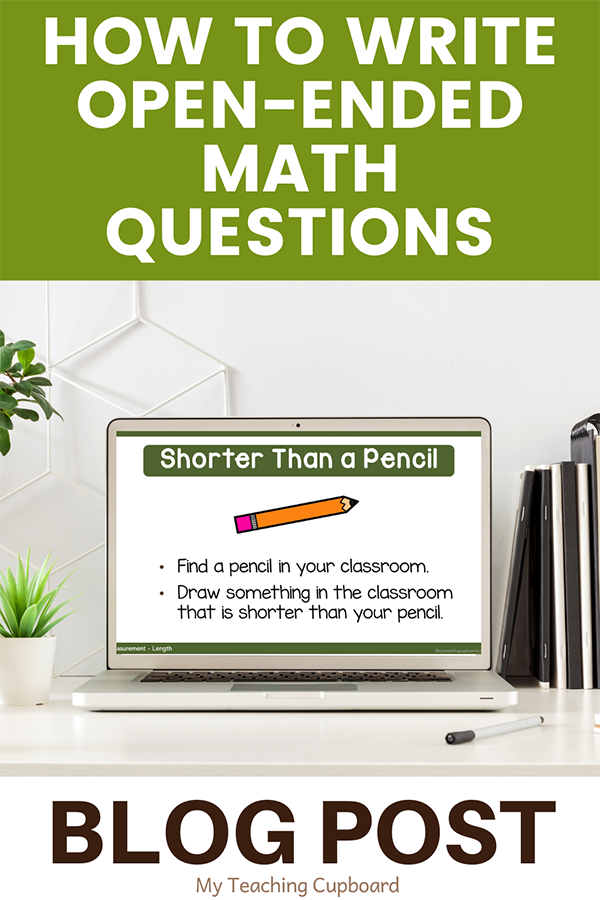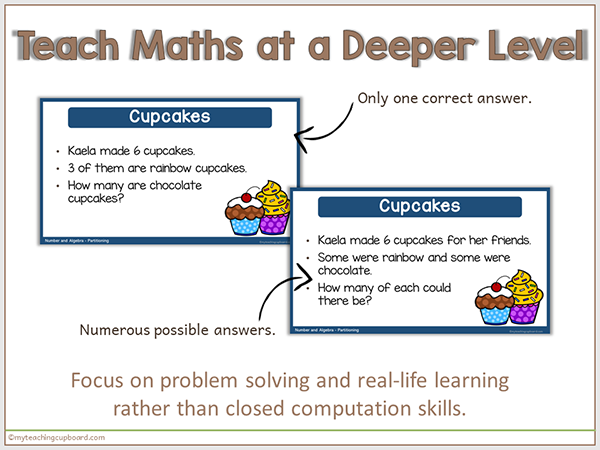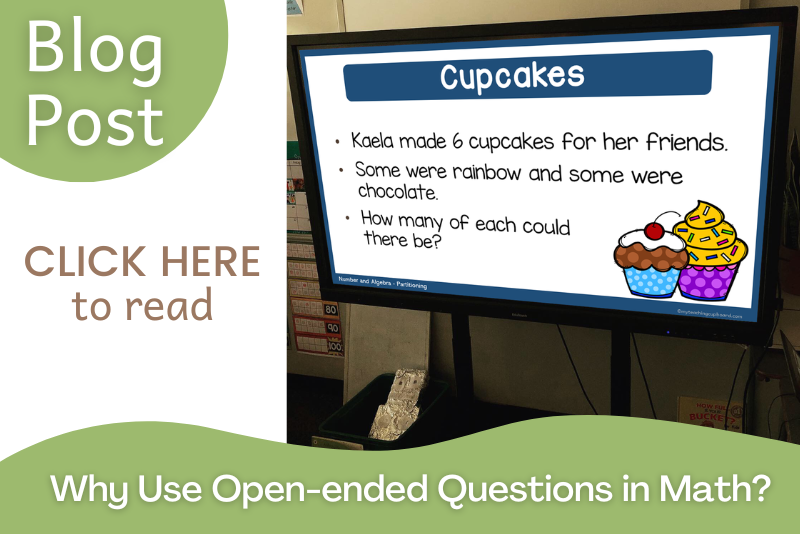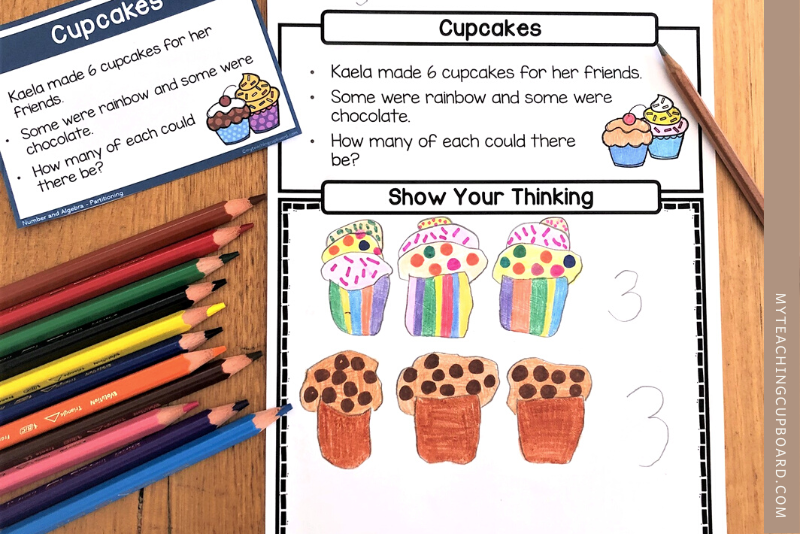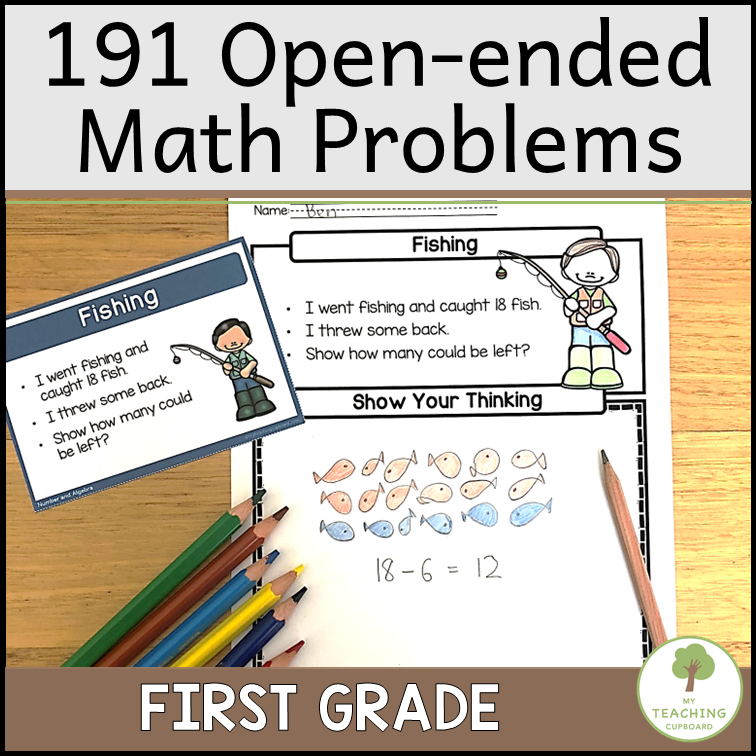How to Write Open Ended Math Questions
Open-ended math questions are problems designed to have multiple correct answers, encouraging critical thinking, creativity, and the application of various math concepts and skills.
If you are wondering how to write open-ended math questions so you can improve your math instruction, this blog post is for you. Discover everything you need to know before you even start writing and then follow my 3 easy steps on how to write the best open-ended math problems.
What are Open-ended Math Questions?
Open-ended math questions (or open-ended math problems) are math problems written with questions that have more than one possible correct solution.
These types of questions encourage students to think creatively and critically about maths. To solve open-ended math problems, students will need to use a range of different math concepts and skills.
Open-ended math problems are usually presented in a word-problem format. They are often about relatable, real-world situations. This helps students to see the purpose math plays in their lives and why maths is so important to learn.
When you use open-ended math questions as part of your math teaching, your students won’t be just reciting math facts or repeating a learned procedure like they do in closed math problems. Open-ended math problems require students to use a deeper level of math thinking.
Closed Versus Open-ended Problems in Math
Very often in our classrooms, the math problems students work on, require only one correct answer. To reach this answer, students need to follow standard mathematical procedures which don’t really encourage higher level critical or creative thinking.
There’s a place for these types of closed math problems but if you are interested in getting your students to use higher-order thinking skills and to work at a deeper level, you need to be using open-ended math problems.
The main difference between these two types of problems is that close-ended problems are closed. There’s just one correct answer. Open-ended problems however have more than one possible correct answer. Students can often use more than one problem-solving strategy to solve them too.
Turning closed math problems into open ones will take your math instruction to the next level and create a very different learning experience for your students.
Among the many benefits of using open-ended versus closed problems in math is the way open-ended math problems are naturally differentiated. Because there are a number of possible correct answers, every student has the opportunity to work through the problem in their own way and at their own level of thinking. Open-ended math questions will give all students a feeling of success. Your students will see themselves as capable math learners.
Read on to discover ALL the benefits of using open-ended questions or open-ended problems in maths.
The Advantages of Open-ended Questions
There are many advantages to using open-ended math questions in your math instruction. We work through one or two of these types of problems every week. When you know all the benefits this type of math teaching can bring, you will understand just how transformational it can be.
Open-ended questions in math:
are naturally differentiated.
are challenging and highly engaging for students.
shift the teaching focus from computation to problem-solving and real-life learning.
provide opportunities for students to record their mathematical thinking.
creates a record of each student’s learning journey in maths.
develop growth mindsets.
foster higher-order thinking skills.
give the teacher insight into students’ capabilities and misconceptions.
build students’ math confidence
improve students’ math language and communication skills.
If you are interested in learning more about why open-ended math problems are so beneficial and, in my opinion, vital for an effective math curriculum, you will want to check out this blog post: Why Use Open-Ended Questions in Math?
Ready to start using these wonderful math problems in your classroom? First, there are a few things you need to know before you even start writing.
Open-ended Questions Should Focus on Thinking Strategies
If you want to write good open-ended math questions, you need to choose suitable math tasks and activities which are designed to focus on higher-order mathematical thinking. The purpose of any open-ended math problem is to shift the math focus from computation to problem-solving.
You need to keep in mind that you are teaching a mathematical idea or concept, rather than mathematical facts. There will always be a need for practice and fluency in mathematical facts however open-ended tasks are more about mathematical thinking. Math thinking that teaches your students to develop deeper math concepts by exploring the connections within mathematical concepts.
When writing open-ended problems for your students, you need to ask questions that have a number of possible solutions. It is also good practice to encourage students to explain their thinking or record their solutions. If young children are required to draw and label the problem solutions, it will help them to consolidate their math understandings. This student created documentation will also give the teacher valuable insight into the students’ thinking.
Open-ended Questions Should be Age Appropriate
The open-ended questions you write should of course be drawn from your math curriculum and align with your math learning intentions, but your first consideration should always be your students. The ability of your students, their previous life experiences, and their current mathematical understandings should guide and inform you.
If you have any experience teaching children in the early years, you know that children don’t all follow the textbook’s developmental stages and certainly don’t all develop at the same rate. For this reason, you need to use your observations and documentation to inform your planning and help you to write developmentally appropriate math problems.
Writing appropriate and suitable open-ended math tasks means you need to consider what prior knowledge your students have, what their interests are, and what mathematical misconceptions they may have.
If you write problems that are too easy or too difficult for your students, engagement will drop. These types of problems are not challenging or motivating and have very little cognitive value either.
Open-ended Questions Should be Relatable
To write relatable open-ended problems you need to ensure the problems reflect real-world situations and experiences your students will be familiar with.
Writing math problems on topics and experiences your students can relate to will help to make their math learning more meaningful and engaging. It will also minimise bias and ensure your students understand the context and vocabulary used in these word problems.
It is important that the real-world situation does not become more important than the math though. Make sure not to over-complicate the topic. You don’t want to be writing math problems that are more about reading comprehension than the actual maths.
Open-ended Questions Should Support Hands-on Learning
Children learn best by doing. For children to effectively engage in problem-solving and for learning to have the biggest impact, your students will need many opportunities for hands-on learning.
Providing math manipulatives, allowing them to act out math problems, and encouraging them to create or draw any possible solutions to the open-ended problems are all great opportunities for hands-on learning.
The math manipulatives you provide during this math instruction need to be familiar to the children. Remember, the focus needs to be on the actual maths and not on how to use a particular math manipulative.
When children create or draw their own representations of their math thinking, it is more relevant to them than some teacher-imposed method of documentation. It could be difficult for a student to link their math understandings to a model imposed by the teacher too.
Student documentation will provide valuable information to the teacher. You can learn a lot about a student’s math understandings and pick up misconceptions that may have otherwise gone undetected.
By encouraging children to use a variety of methods and materials to document their mathematical thinking, you will be helping your students to develop and consolidate their math concepts. Children need multiple opportunities to test and re-test their thinking if they are to build strong math understandings.
How to Write Open-ended Math Questions
Now we have covered most of the things you need to know before you start writing any open-ended questions for your students, let’s look at 3 ways to write some open-ended math problems.
1. Start with a Closed Question
It’s quite easy to write an open-ended math question if you just reverse engineer a closed math question. For example, you could start with a traditional type of closed question like:
Kaela has 6 cupcakes. If 3 of them are rainbow, how many are chocolate?
Now you just need to re-word it so it becomes a differentiated open-ended math problem with numerous possible answers. Turn it into something like:
Kaela has 6 cupcakes. If some are rainbow and some are chocolate, how many of each could there be?
To make it even more open-ended, experiment with questions that have no stated quantities like this one:
Kaela has some cupcakes. She has some rainbow and some chocolate. How many cupcakes could Kaela have and how many of each could there be?
2. Ask Students to Justify their Math Thinking
This way of writing an open-ended question requires students to draw on their prior knowledge and asks them to prove certain math facts are true. Very often they need to explain their math thinking and conceptual understandings in these types of problems too. When writing an open-ended problem like this, start the question with any of these words:
Prove.. Explain.. Show.. Describe.. or Illustrate..
Here are some examples of these types of open-ended problems:
Prove 4 + 4 = 8
Explain why a square has 4 sides.
Show all the different ways you can represent the number 9.
Describe what a pattern is.
Illustrate an o’clock time.
Did you notice there are multiple correct responses possible? These types of math problems are great for getting your students to demonstrate their thinking with a variety of math tools and resources. Your students could use math manipulatives, they could draw a picture, or give a written response.
3. Ask Students to Compare Math Concepts
To write these types of open-ended math problems you need to choose a math concept related to your learning intentions. Then you need to ask students to compare two examples or show the similarities and differences.
For example, you might choose a math concept related to any of the content strands: Number & Algebra, Geometry, or Measurement. Here are some example comparison questions for each strand:
Number & Algebra – How are numbers 15 and 17 the same?
Geometry – How is a square different from a cube?
Measurement – What is longer than your pencil?
Open-ended Math Questions Done For You
If you are interested in using open-ended math problems in your kindergarten or grade one classroom but don’t have the time to write a whole lot of questions, I have something you might like.
I believe using open-ended questions in maths is a vital part of a well-rounded math curriculum. I wanted questions that I could use throughout the whole year so I spent a lot of time creating two massive sets of questions. There’s a set for the Foundation stage and one for Grade one.
You can use these 164 open-ended math problems in your whole class and small group math warm-ups and guided math lessons. They will make teaching problem-solving quick and easy.
These word problems are all fully aligned to the Australian Curriculum – Foundation Stage.
When I wrote these differentiated math questions, I made sure they all have multiple possible answers. This way they will suit the diverse range of learning abilities I have in my class.
My students found them very engaging and they got quite excited about working on them.
These problems are age-appropriate too. They are all designed around popular kindergarten topics and interests.
We usually do one of these problems each week and with 164 open-ended questions in this resource, there’s more than enough for the whole year!
This grade one pack contains 191 open-ended math problems. I’ve used them in whole class and small group lessons. They come in handy as math warm-ups or as an introduction to a guided math lesson too.
They are all aligned to the Australian Curriculum – Grade 1.
Just like the kindergarten set, each open-ended problem is differentiated and has multiple possible solutions. I know how important it is to cater to the diverse range of learning abilities you have in your class.
Again, it’s easy to keep your students engaged and excited about maths with these age-appropriate math tasks because they are all designed around popular first grade topics and interests.
In grade one, we do at least two of these problems each week and with 191 open-ended questions in this resource, you again have plenty to choose from.
BOTH SETS CONTAIN 3 VERSIONS
A PowerPoint Presentation
Set of matching Task cards – 4 to a page
Set of Matching Worksheets
For a whole class guided math lesson or warm-up, just display your chosen problem on a large screen or interactive panel. For small group or individual math activities, use the task cards or matching worksheets.
Open-ended math questions will transform your math instruction.
Remember when using open-ended math questions like these, the focus needs to be on the strategies your students are using and not just the answer to the problems. Success at using open-ended math tasks lies in the math skills and understandings your students use rather than any superficial indicators like speed or correctness of an answer.
You will get even more out of these tasks when you provide opportunities for discussions and by listening to students explain their thinking. Not only will you be teaching important math skills but you’ll be gaining valuable insights into the math understandings your students have.
If you found this blog post on how to write open-ended math questions helpful, please consider sharing it… Just CLICK the sharing box below.👇

